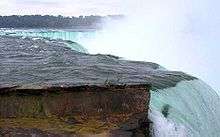Caprock
Caprock or cap rock is a harder or more resistant rock type overlying a weaker or less resistant rock type.[1] Common types of caprock are sandstone and mafic rock types. An analogy of caprock could be the outer crust on a cake that is a bit harder than the underlying layer. Common caprock locations are escarpments, mesa formations, and salt domes. In the petroleum industry, caprock is generalized to any nonpermeable formation that may prevent oil, gas, or water from migrating to the surface.
Description

Caprock is a harder or more resistant rock type overlying a weaker or less resistant rock type.[1] Common types of caprock are sandstone and mafic rock types. An analogy of caprock could be the outer crust on a cake that is a bit harder than the underlying layer. In processes such as scarp retreat, the caprock controls the rate of erosion of the scarp. As the softer rock is cut away, periodically the caprock shears off. Caprock is also found on the top of mesa formations.
The Niagara Escarpment, over which Niagara Falls flows, is an example of a scarp or escarpment. At Niagara Falls, the caprock is the riverbed above the falls, and is what prevents the river from eroding the face of the falls very quickly. In the photo, the dark thin layer in the foreground where water is not yet running, is the caprock. The Niagara caprock is made of dolomitic limestone.
Petroleum
In the petroleum industry, caprock is any nonpermeable formation that may trap oil, gas or water, preventing it from migrating to the surface. This caprock or trap can create a reservoir of oil, gas or water beneath it and is a primary target for the petroleum industry.
Salt dome caprock
The tops of salt domes such as in the Gulf of Mexico dissolve in a characteristic manner, and can range between 0–1500 ft thick.[2] The halite (salt) is removed first, leaving behind gypsum and anhydrite. The anhydrite and gypsum react with organic material to form calcite. The classic Murray 1966 paper[3] describes the generalized sequence as sediments-calcite-gypsum-anhydrite-salt.
References
- Kearey, Philip (2001). Dictionary of Geology, 2nd ed., Penguin Reference, London, New York, etc., p. 41.. ISBN 978-0-14-051494-0.
- Walker, Charles W. (Dec 1976). "Origins of Gulf Coast Salt-Dome Cap Rock". AAPG Bulletin. 60 (12): 2162–2166. doi:10.1306/c1ea3aa0-16c9-11d7-8645000102c1865d. Retrieved 2010-09-07.
- Murray, Grover E. (Mar 1966). "Salt structures of Gulf of Mexico basin--a review". AAPG Bulletin. 50 (3): 439–478. doi:10.1306/5d25b49d-16c1-11d7-8645000102c1865d. Retrieved 2010-09-07.